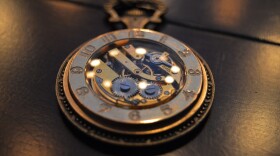
It’s a two for one as we visit Gemini Handmade in downtown Grand Rapids as part of our Artisans of Michigan series.
The boutique-studio-workshop is home to two businesses. Jacob Vroon’s company is Harbinger Leather Design. Elyse Welcher owns Littlewings Designs.
The two artisans are married.
“Funny enough, we met as competitors in town. We both had our own lines and we were competitors at craft shows. There was a little bit of that like –it was very professional- he’s another leatherworker. Kept it very (much) on that level,” Elyse Welcher said, laughing.
She adds that it’s not all that common for a husband and wife to both be artists.
“Sometimes you are, but you work in different mediums. It’s pretty rare that two artists that work in the same type of medium get together,” she said.
Jacob Vroon says it works for them.
JV: “One way in which Elyse and I complement each other with the ways our brains work and the ways our businesses work. Sometimes Elyse will take the forefront on the organizational side of things, the communication thing, the insurance, the taxes, etcetera and I will take on the batch manufacturing of my goods and her own. So, when our strengths cover each other’s weaknesses, it makes it better for both of us to get along.”
EW: “I mean, we both love working with our hands. We’re both very kinetic hands-on people and so that process of just being able to get into that flow-state of making things, you know, it’s where we find our most joy. On the other hand, it’s tiring. I think that’s the biggest thing is that the impact on our bodies is real. You know, we’re constantly cutting, pulling, moving stuff around. You know, outside of the making, we do a lot of crafts shows and events. So, every summer weekend we’re loading and unloading an entire booth set up with a 10 by 10 easy-up tent and all of the equipment and gear that goes in that. So, it’s very physical, active work.”

Both of them got into leatherwork because they could not find the kind of products they wanted in the marketplace. So they started making them, or at least trying to make them. Vroon says his first project was a leather book bag. He found a pattern, and followed it, but that pattern was designed for lighter weight material.
“It looked terrible. And so, I cut apart everything that I’d hand stitched, whittled it down, put it back together. It was slightly better. So, after six iterations of trying to make myself the same bag from the same pieces, I wasn’t ready to stop. So, every paycheck I would get another piece of leather, another few tools and take over some more of the dining room in the house I was renting,” he said.
Welcher just felt there was a big gap in leather goods for women.
“I didn’t see the type of leather goods that, frankly, I wanted in the world. I saw a lot of things that were either your very high-end Hermes designer type goods, a lot of Harley biker stuff, and a lot of, you know, Filson, very ‘let’s go into the woods and camp out’ sort of thing. I wanted something that was a little more playful and a little more feminine, but that also was built to last and made well, that wasn’t a junky bag or so expensive that it was like buying a car,” she said.
She’s attracted to leather because so much of today’s quick fashion world is about getting cheap goods into the store and sold as quickly if possible.

“So much of that clothing is never actually even purchased. It comes in. It goes out. It never gets bought. It goes to landfills. It goes to third world countries. It creates a tremendous amount of waste. And then, the buyers who buy those products, they don’t last. They wear them twice. They fall apart in the washing machine and it’s game over and you throw it in the dump,” Welcher said.
She makes handbags and playful accessories while Vroon makes wallets, backpacks and more rugged sort of outdoorsy products.
“A leather worker that I follow on Instagram said recently that their goal is to make goods that if someone sees it at an estate sale a hundred years from now, they’re going to say, ‘Oh, that’s great! I need to have that,’ even after it’s been banged up and passed down. I want things that will last,” he said
Their shop, Gemini Handmade, features their work, Littlewings Designs and Harbinger Leather Design as well as the work of other artisans and designers in the region, including a Michigan Radio Artisan of Michigan featured last summer, Kate Lewis Ceramics.
Support for arts and culture coverage comes from the Michigan Council for the Arts and Cultural Affairs.
Artisans of Michigan is produced in partnership with the Michigan Traditional Arts Program of the Michigan State University Museum.











